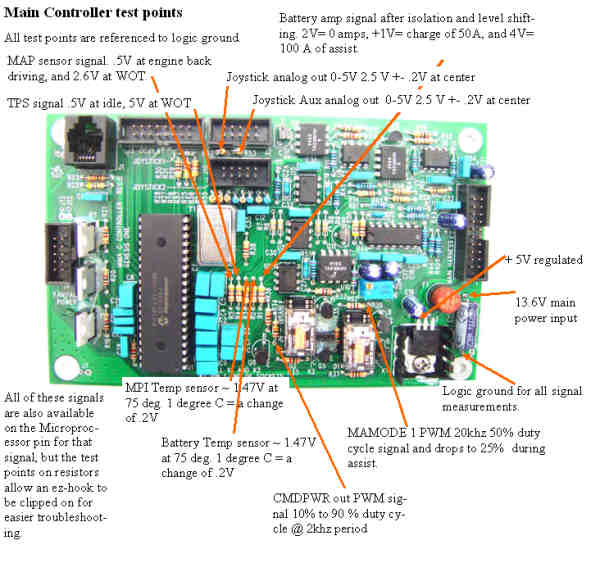|
Theory of OperationThe Honda Insight was introduced in this country in 2000, in a rushed development to beat Toyota to the American market with the first production Hybrid. The control system of the Insight is made up of a modular programming jack and the availability of an inexpensive program configuration with comparatively simple communication between the modules. MIMA _L was the first system to hijack the control signals concerning the assist and charge functions, and was fabricated with only a few chips. The three signals that communicate to the MCM what the ECM wants for assist or charging, is the basis of MIMA.
1. The MAMODE 1 signal is a 20 khz pulse train that is sent from the ECM to the MCM, and sits at about 50% duty cycle when no assist is requested. The duty cycle shifts to 25% duty when full assist is requested. It was found that forcing this signal to 25% duty cycle was all that was needed to enable full assist, but this signal alone will not allow control of the actual assist level, rather acting only as an enabler.
2. MAMODE 2 signal is a simple logic signal that is pulled high in the MCM. The ECM will pull this line low when assist of any level is requested, so it is the first enabler of assist, with the MAMODE 1 duty cycle shift as the full assist enabler.
3. CMD PWR is a 2 KHZ variable duty cycle signal that is the main control signal for the level of assist or charging . This signal duty cycle drops to 10 % duty at full charging, and raises to 90% duty cycle for full assist.
If either of the MAMODE 1 or the CMDPWR signals are missing when the car starts, or during operation, the IMA fault indicator will illuminate and disable the complete IMA system. A MCM reset will correct this condition.
The MIMA system breaks the path from the ECM to the MCM for the MAMODE1, and the CMDPWR signals, with relays that reconnect the cars stock signals when deactivated.
To keep the control logic to the simplest form when in MIMA active mode, MIMA simply replaces the MAMODE1, and CMDPWR signals with replacement signals that change duty cycle under the Joystick control.
Soon it became obvious that with the more aggressive use of assist and recharging functions that MIMA allowed, battery and power electronics were caused to run on the hot side, and it was found that the cooling fans were not turned on early enough and were turned off during autostop. Temperature probes were installed into the battery pack and onto the heat sink of the MPI. The fans were brought under MIMA control through a diode "or" configuration, that allows all fans to operate normally under the car's normal control systems, and allows MIMA to turn them both on full. MIMA will activate the fans when either the Battery or MPI heat sink get to over 95 degrees.
The assist charge display of the Insight gives only an approximate indication of current going into or out of the battery, so a tap into the battery current sensor allows MIMA to more accurately measure the battery current and display it in real time on the battery amp LEDs. In the future, this will allow MIMA to compute SOC of the battery since it is monitoring the same battery current signal that the BCM is when making the SOC determinations. This allows for independent determination of the SOC.
To allow more possibilities for the use of the new level of control that MIMA provides, it also captures the VSS (Vehicle Speed Signal), The MAP (Manifold Absolute Pressure), and the TPS (Throttle Position Sensor). From the VSS, we can determine speed and acceleration/deceleration of the vehicle. From MAP we can determine engine loading and derive efficiency. From the TPS, we can determine what the operator wants to do, and how fast he wants it to happen.
PIMA (Programmable IMA) can automatically activate assist and charging in a similar way to the standard IMA action, with one major difference. Assist and charge set points are adjustable as is rate of engagement after crossing the set point. These can all be adjusted in real time while driving.
The programming jack provided with MIMA, along with an inexpensive programming tool and free development system, gives us a cool system that will continue to evolve as we use it and explore different ways to optimize the PIMA software for hyper mileage or hyper performance.
|
 | |
|
|
|